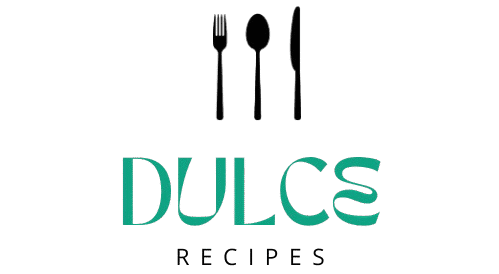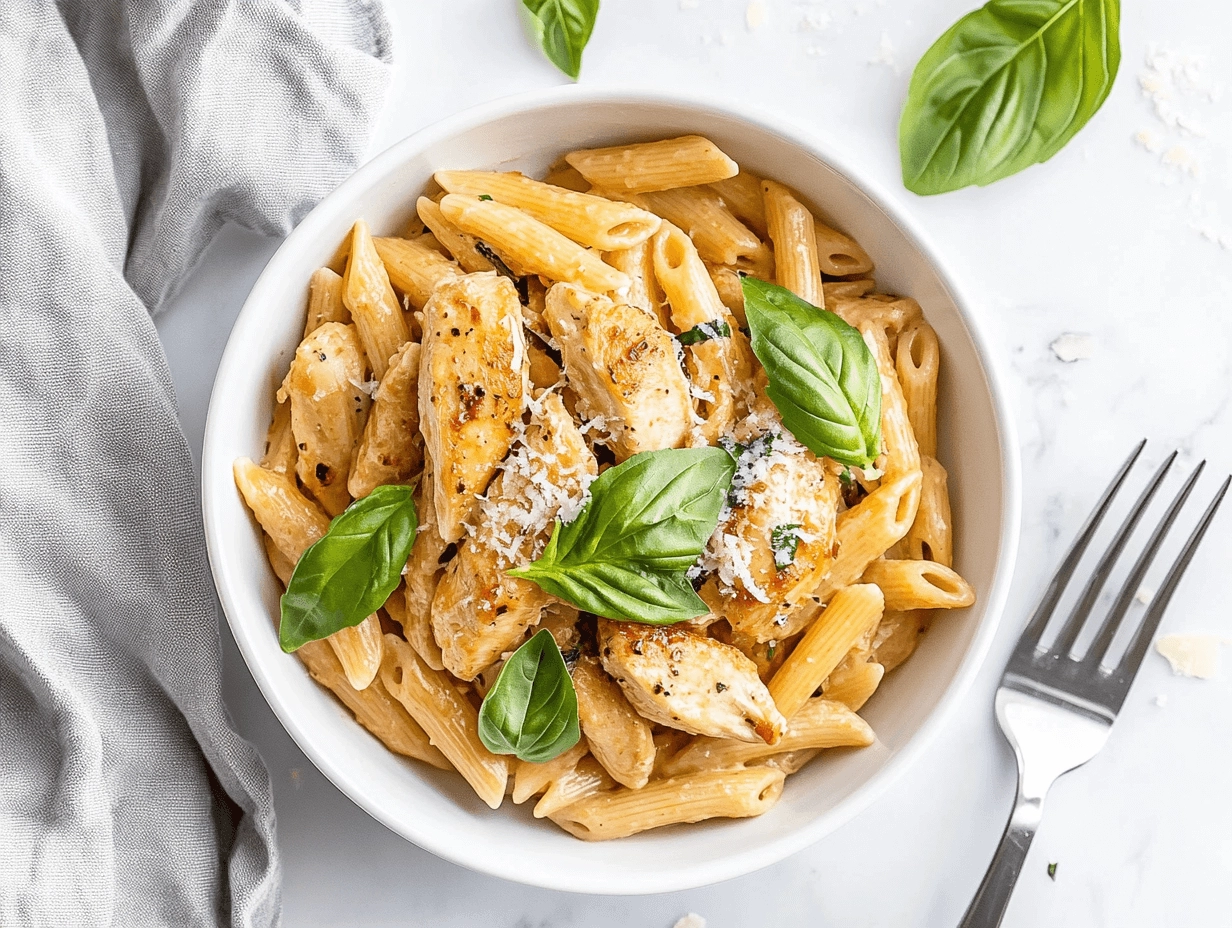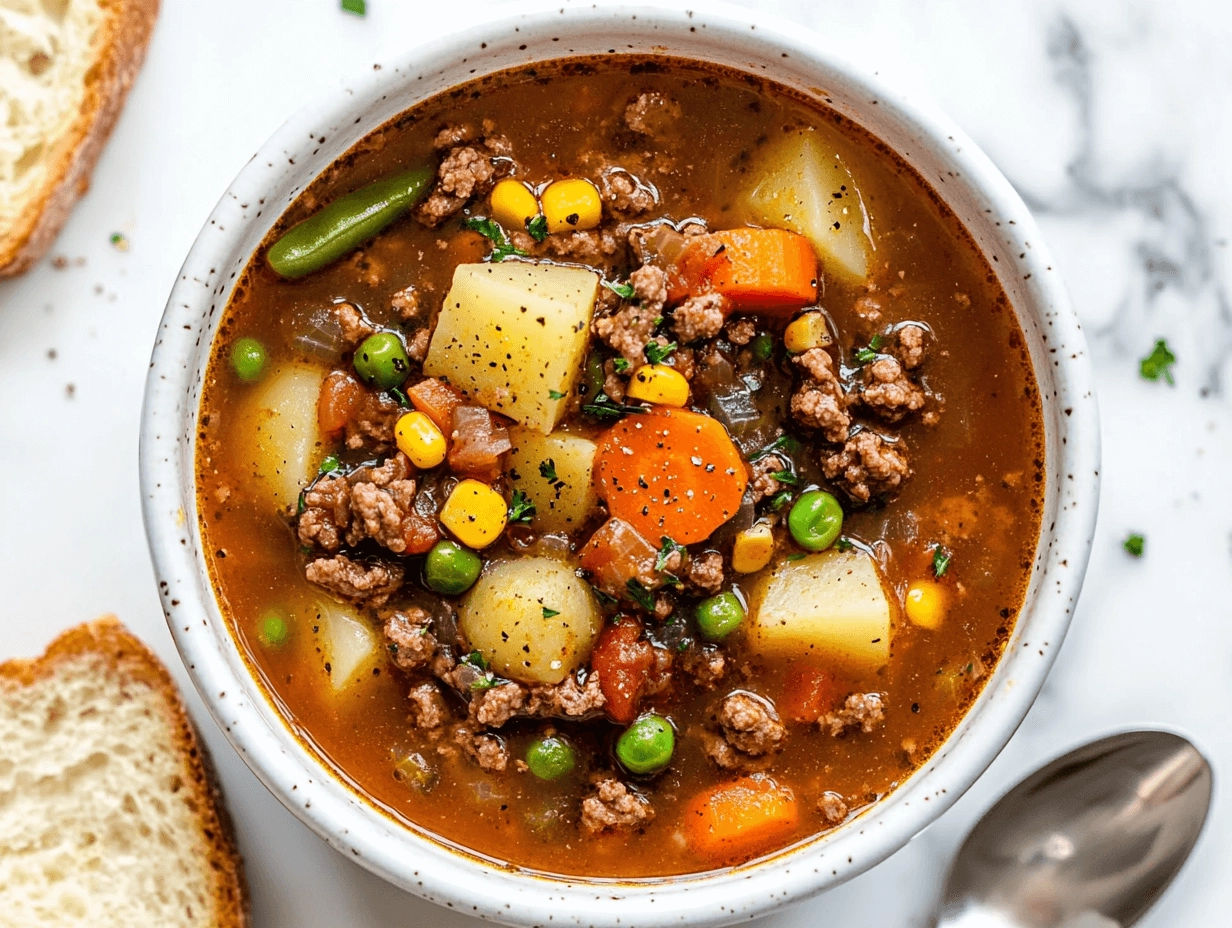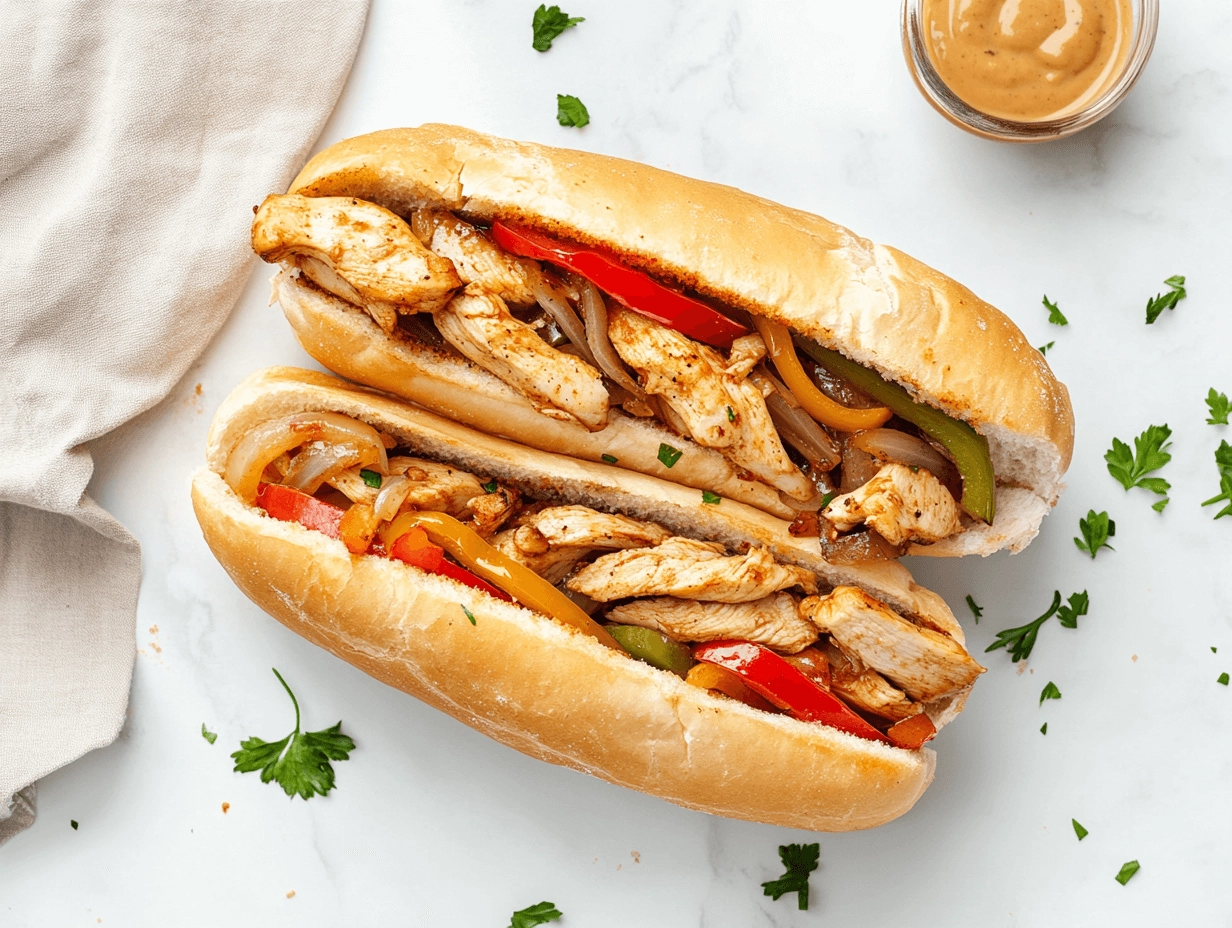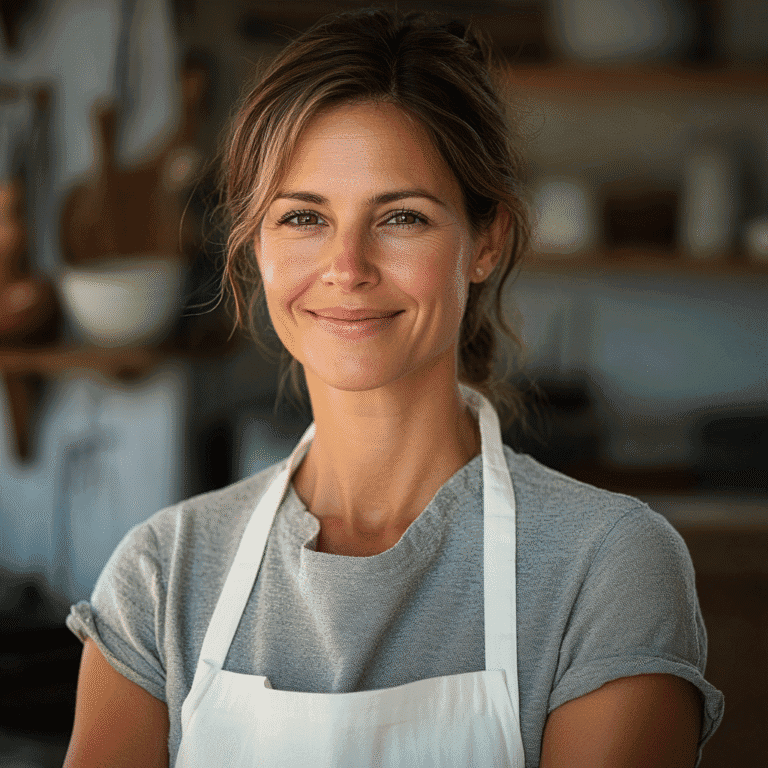As a home cook, I always wanted to master French cuisine. The first time I cooked like a Parisian, it changed everything. The smell of butter, herbs, and seared meats made my meals unforgettable.
French dinner recipes are more than food; they’re stories of tradition and passion. These five dishes will take you on a journey through French cooking. It’s about making memories at your dinner table.
Whether you’re new to cooking or experienced, these French meal ideas will inspire you. You’ll learn to cook like the French, with classic dishes and advanced techniques. Bring France to your kitchen with these recipes.
Table of Contents
Discover more delicious recipes and ideas by visiting our homepage!
Understanding the Art of French Cuisine
French cuisine is more than just cooking. It’s an art form that values every detail. It shows deep respect for the ingredients used.
To explore French cooking, you must grasp its core principles. A French meal is not just about food. It’s a journey for your senses.
Quality Ingredients: The Foundation of Excellence
French cooking starts with the best ingredients. Chefs choose fresh, local, and seasonal items. This makes each dish special.
- Locally grown vegetables
- Artisanal cheeses
- Fresh herbs
- High-quality meats and seafood
Essential French Cooking Techniques
Learning French cooking takes time and skill. These techniques make French food elegant:
- Sautéing: Quick cooking in hot fat
- Braising: Slow-cooking meats in flavorful liquid
- Deglazing: Creating rich sauces from pan drippings
- Reduction: Concentrating flavors by simmering
Traditional French Meal Structure
A French meal follows a set order. This makes dining a refined experience. It includes:
- Apéritif: Light drinks and small appetizers
- Entrée: Starter course
- Plat Principal: Main dish
- Fromage: Cheese course
- Dessert
- Digestif: Closing drink
Learning these principles will help you master French cooking. It will improve your cooking skills.
Classic French Dinner Recipes to Master
Exploring classic French dishes is like going on a food journey through France’s rich history. If you’re looking for good French entrees, get ready for a taste adventure. You’ll discover authentic flavors and cooking methods that have stood the test of time.
French cuisine is known for its elegant and sophisticated dinner recipes. These dishes have won the hearts of food lovers around the world. Inspired by Julia Child’s “Mastering the Art of French Cooking,” we’ll look at some essential French entrees. They will elevate your home cooking to new heights.
- Coq au Vin: A legendary chicken dish braised in Burgundy wine
- Beef Bourguignon: A rich, slow-cooked beef stew with deep flavor complexity
- French Onion Soup: A classic starter that doubles as a hearty meal
- Bouillabaisse: A seafood stew originating from Provence
- Quiche Lorraine: A savory egg tart with bacon and cream
Each classic French dish has its own story and tradition. They show the art of slow cooking, precise techniques, and choosing the best ingredients. By mastering these recipes, you’ll wow your dinner guests. You’ll also learn about the heart of French cooking.
Coq au Vin: A Timeless French Comfort Dish

Explore French main course recipes with Coq au Vin, a classic dish. It’s a comfort food that turns simple ingredients into a masterpiece. It takes you on a journey to the French countryside with every bite.
Wine Selection Tips for Coq au Vin
Choosing the right wine is key for authentic French pairings. For Coq au Vin, pick a robust red wine like Burgundy or Pinot Noir. It should be full-bodied with enough acidity to balance the dish’s rich flavors.
- Recommended wines:
- Burgundy
- Pinot Noir
- Côtes du Rhône
- Avoid overly tannic wines
- Select a wine you’d enjoy drinking
Perfect Side Dish Pairings
Pair your Coq au Vin with traditional French sides. Creamy mashed potatoes or crusty French bread soak up the sauce perfectly.
- Recommended sides:
- Buttered egg noodles
- Roasted root vegetables
- Crispy baguette slices
Step-by-Step Preparation Guide
Making this classic recipe takes patience and detail. Marinate the chicken for 2-12 hours for deep flavors. Sear the chicken for 4-5 minutes per side for a golden-brown color.
- Marinate chicken in red wine
- Sear chicken pieces
- Cook bacon and vegetables
- Simmer chicken in sauce for 30 minutes
- Caramelize pearl onions and mushrooms
This dish has 542 calories per serving, with 54% from protein and fat. It’s a balanced meal with potassium and iron.
Authentic Bouillabaisse from Provence
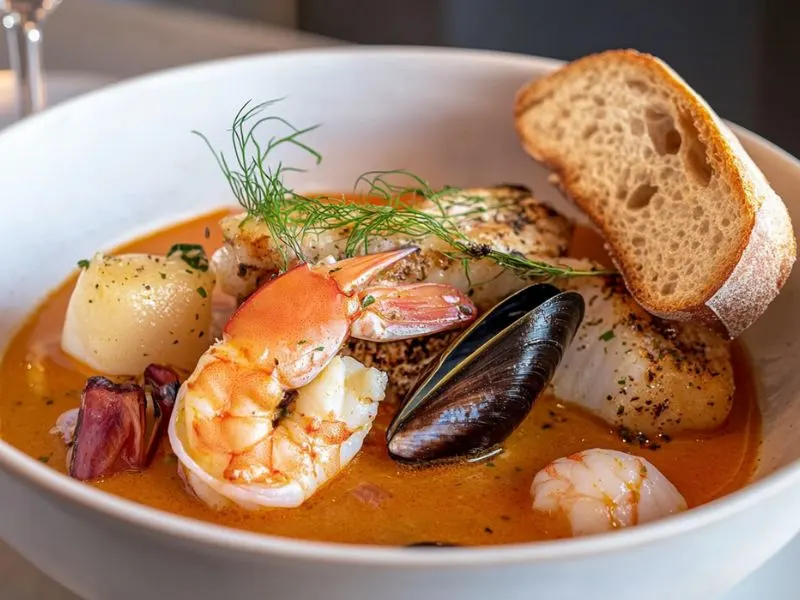
Explore the essence of Provençal cuisine with bouillabaisse. This legendary french dinner recipe is a true taste of Marseille’s coastal spirit. It’s more than a meal; it’s a journey through the Mediterranean’s rich culinary traditions.
Bouillabaisse comes from Marseille, a city known for its seafood. The dish reflects Provence’s love for the sea. It’s a key part of local parisian recipes.
- Traditional ingredients include multiple varieties of local fish
- Typically prepared with rockfish, sea robin, and red mullet
- Accompanied by a signature rouille sauce
Making authentic bouillabaisse needs fresh seafood and special cooking skills. In Marseille, this dish is a symbol of pride. It shows how different cultures shape Provençal cooking.
| Key Ingredient | Significance |
|---|---|
| Mediterranean Fish | Ensures authentic flavor profile |
| Saffron | Provides distinctive golden color and aroma |
| Fennel | Adds traditional Provençal herbaceous notes |
When making this french dinner recipe, serve it with Provençal rosé wine. The wine’s coolness complements the stew’s rich flavors. It makes for a truly authentic meal.
Every region in France adds its own twist to dishes. Bouillabaisse is a proud example of Provence’s culinary art. By learning this recipe, you can bring a piece of the French Riviera to your table.
French Onion Soup with Gruyère Croutons
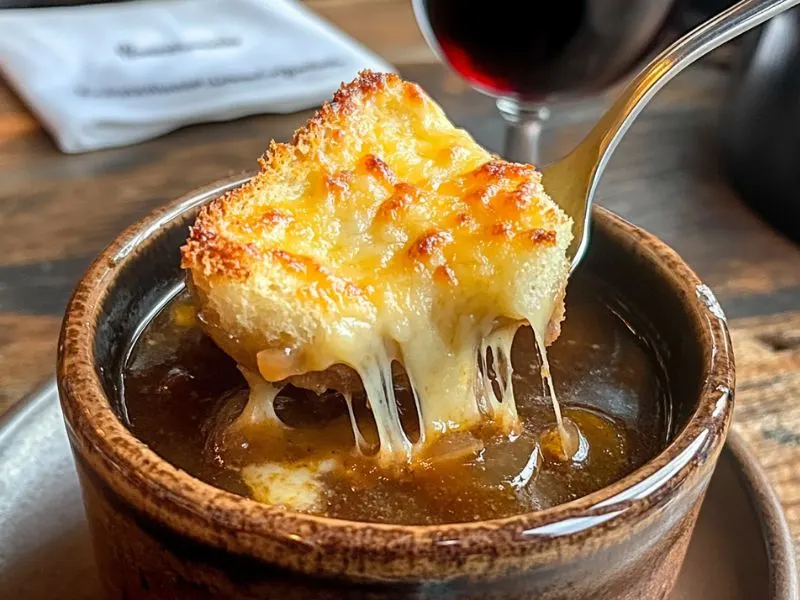
French onion soup is a classic dish that shows off French cooking at its best. It turns simple ingredients into a rich, comforting meal that warms your heart and soul.
Choosing the Right Onions
For the best flavor, pick yellow onions. You’ll need 5 large yellow onions and 4 large shallots. Look for sweet, firm onions with no blemishes.
Proper Caramelization Techniques
Caramelizing onions takes patience and care. Here’s how to do it right:
- Cook onions on low heat for 30-40 minutes
- Stir every 3 minutes during the first half of cooking
- Increase stirring to every minute in the second half
- Use 3-4 tablespoons of olive oil and 3 tablespoons of salted butter
Wine and Broth Selection
Choosing the right ingredients is key. Use 3 quarts of beef stock and a dry white wine for depth of flavor.
| Ingredient | Quantity | Purpose |
|---|---|---|
| Beef Stock | 3 quarts | Base liquid |
| Gruyère Cheese | 2 cups | Topping |
| Rustic Bread | 6 thick slices | Croutons |
To serve, broil the cheese-topped croutons for 2-4 minutes until golden. Your French onion soup is now ready to wow your guests!
Beef Bourguignon: The Ultimate French Stew
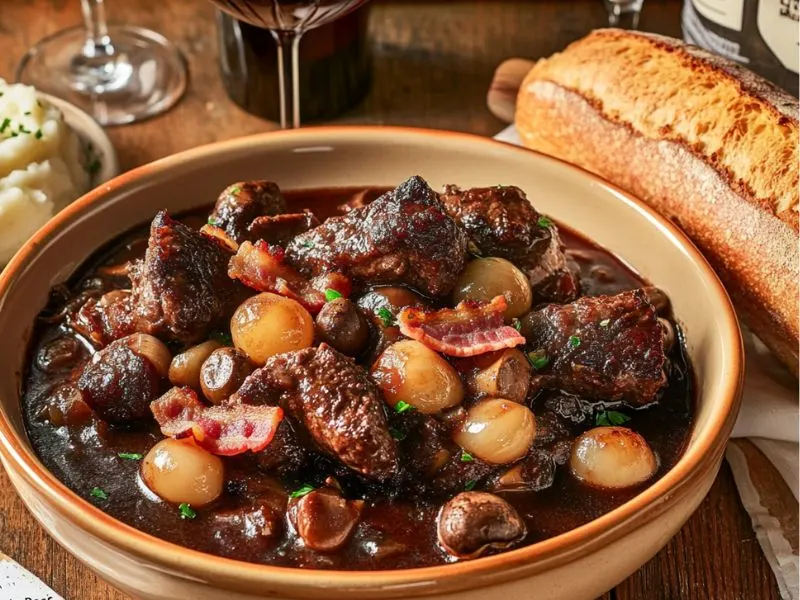
Explore the world of classic French dishes with Beef Bourguignon. It’s a quintessential French main course recipe that turns simple ingredients into a masterpiece. This rich, hearty stew comes from the Burgundy region of France. It’s the peak of rustic French cooking.
The secret to Beef Bourguignon is in its ingredients and slow-cooking method. You’ll need top-quality beef, like chuck steak or short ribs. These cuts become incredibly tender after hours of braising in red wine.
- Primary meat: 1.5 lbs (500 g) chuck steak or short ribs
- Wine selection: 1 bottle (750 ml) full-bodied red wine
- Key vegetables: 5 small spring carrots, 10 quartered mushrooms
- Aromatics: 2 bruised garlic cloves, bouquet garni
Making the perfect Beef Bourguignon takes patience and detail. The process includes searing the meat until it’s dark brown, sautéing vegetables, and slow-cooking in the oven at 325°F (160°C) for about 3 hours.
| Ingredient | Quantity |
|---|---|
| Beef | 1.5 lbs (500 g) |
| Red Wine | 750 ml |
| Bacon Lardons | 250 g |
| Cooking Time | 3 hours |
Pro tip: This classic French main course recipe tastes better the next day. This is because the flavors deepen and become more intense. Serve it with crusty bread or buttery mashed potatoes to enjoy the rich, wine-infused sauce.
Essential Kitchen Tools for French Dinner Recipes
Mastering French cooking techniques is not just about skill. It also needs the right tools. The right kitchen equipment can turn a simple meal into a French culinary masterpiece.
To make authentic French dishes, you need the right tools. Each piece of cookware is key to perfecting French cooking techniques. These techniques are what make French cuisine so special.
Must-Have Cookware for French Cuisine
- Dutch Oven: Essential for slow-cooking stews like Coq au Vin and Beef Bourguignon
- Cocotte: Ideal for preparing delicate casseroles and braised dishes
- Heavy-bottomed saucepans for creating smooth sauces
- High-quality cast-iron skillet for perfect searing
Specialty Utensils for Precision
| Tool | Purpose |
|---|---|
| Mandoline | Precise vegetable slicing for uniform cuts |
| Wine Opener | Essential for wine pairings and cooking |
| Wooden Spoons | Gentle stirring without scratching cookware |
Investing in these tools will improve your French cooking skills. It will turn your kitchen into a true French culinary space. Remember, quality tools are the base of great cooking.
Wine Pairing Guide for French Dishes
Learning about french wine pairings is key to a true french gourmet meal. Wine turns a simple meal into a special experience. It makes each bite better with the right flavors and smells.
To pair wine well, you need to know the dish and the wine’s traits. Different wines go with various dishes based on taste, body, and strength.
- Light-bodied wines pair perfectly with delicate seafood dishes
- Full-bodied red wines match rich meat preparations
- Regional wines traditionally complement local cuisine
When looking into french wine pairings, keep these tips in mind:
| Wine Type | Recommended Dish | Flavor Profile |
|---|---|---|
| Pinot Noir | Coq au Vin | Light, fruity red |
| Chardonnay | Seafood Dishes | Crisp, buttery white |
| Bordeaux | Beef Bourguignon | Rich, tannic red |
Sparkling wines like Champagne are very versatile. They pair well with appetizers and main courses. A well-selected wine can make your meal even better, highlighting the dish’s flavors.
The aim of french wine pairings is to create a perfect culinary journey. It should delight all your senses.
French Cooking Tips and Common Mistakes to Avoid
Mastering French cooking takes precision and detail. Whether you’re making classic dishes or trying new recipes, knowing key principles can boost your skills a lot.
French cooking is all about controlling temperature and seasoning. Professional chefs succeed by understanding the small details of cooking.
Precision in Temperature Management
Getting the right temperature is key in French cooking. Follow these important tips:
- Use a reliable kitchen thermometer for accurate readings
- Learn the difference between searing and burning proteins
- Control heat levels for delicate sauces
- Understand slow-cooking techniques for classic French dishes
Seasoning Secrets for Authentic Flavor
Seasoning is what makes your French dishes stand out. Here are some expert tips:
| Technique | Key Recommendation |
|---|---|
| Herb Usage | Add fresh herbs at the end of cooking for maximum flavor |
| Salt Application | Season gradually and taste throughout cooking process |
| Spice Blending | Create depth by layering complementary spices |
Remember, French cooking is all about finesse. Be patient, respect your ingredients, and learn from each dish. Your skills will grow with every meal you make.
Proper French Table Setting and Serving Etiquette
To have a true French dining experience, it’s not just about the food. Knowing how to set the table is key. It turns a simple meal into a special event. French dinners have many steps that show off their culture and love for food.
French meals are divided into four main times: le petit-déjeuner (breakfast), le déjeuner (lunch), le goûter (afternoon snack), and le dîner (dinner). Each time has its own special way of setting the table and serving food.
French Table Setting Elements
- 90% of place settings include personalized handwritten place cards
- 70% feature blue and white color schemes
- 100% incorporate decorative porcelain accents
- 40% utilize soft linen napkins
- 100% include candle arrangements for warm ambiance
Dining Etiquette Essentials
| Etiquette Rule | Practice |
|---|---|
| Bread Handling | Tear, never slice |
| Salad Service | Served after main course |
| Greeting | Say “bon appétit” before eating |
Your table should be simple yet elegant. Add touches like blue hydrangeas and mix old and new flatware. Remember, the most important thing is to enjoy good conversation. By following these tips, you’ll make your dinner feel like a French celebration.
Conclusion
Your journey through French meal ideas has shown you the depth of French cuisine. You’ve seen how chefs like Georges Auguste Escoffier use detailed techniques. And how simple ingredients from local markets can create amazing dishes.
These recipes are just a small part of French culinary traditions. You’ve learned that 70% of French meals include cheese and 90% use regional wines. This shows that French cuisine values quality, passion, and respect for ingredients.
Each dish tells a story of regional pride. From Burgundy’s complex stews to Provence’s vibrant seafood, every meal has a story.
As you keep exploring French cuisine, remember that cooking is a journey. You’ve learned important techniques like caramelization and wine pairings. These skills will make your kitchen a place of creativity.
Whether you’re making a simple baguette meal or a fancy dinner, French cooking is all about patience, precision, and enjoying the process.
Your new skills invite you to keep exploring and enjoying French gastronomy. Bon appétit!
FAQ
What are the main components of a traditional French dinner?
A traditional French dinner has many parts. It starts with an aperitif, a pre-dinner drink. Then comes the starter, or entrée. Next is the main course, or plat principal.
After that, there’s a cheese course. The meal ends with dessert. It’s finished with coffee and sometimes a digestif.
What are some essential cooking techniques in French cuisine?
French cooking uses many techniques. These include sautéing, braising, and poaching. You also need to know how to make reductions, caramelize, and deglaze.
Learning these methods is key. They help make dishes like Coq au Vin and Beef Bourguignon authentic.
How important is wine selection in French cooking?
Wine is very important in French cooking. It’s used for both drinking and cooking. The right wine can make a dish taste better.
For example, use Burgundy wine for Beef Bourguignon. A crisp white wine is good with seafood.
What are the four main meals in French daily dining?
The French have four main meals. These are:
– Le petit-déjeuner (breakfast)
– Le déjeuner (lunch)
– Le goûter (afternoon snack)
– Le dîner (dinner)
What tools are essential for French cooking?
For French cooking, you need a few tools. A Dutch oven and cocotte are must-haves. You also need a mandoline, sharp knife, and wooden spoons.
A soup pot and wine opener are also important. These tools help you cook French dishes with precision.
How do I properly caramelize onions for French Onion Soup?
To caramelize onions, slice them thinly. Cook them slowly in butter over low heat, stirring now and then. It takes 30-45 minutes.
You want them to turn golden-brown without burning. This slow cooking makes them sweet and adds flavor to the soup.
What makes French cuisine unique?
French cuisine stands out for its focus on quality and freshness. It uses precise techniques and pays attention to presentation. The dishes reflect the region they come from.
It’s all about bringing out the natural flavors of ingredients. This careful approach makes French food special.
How can I pair wines with French dishes?
When pairing wine with French dishes, think about the food and wine’s intensity. Match light dishes with light wines and heavy dishes with robust wines. For example, Coq au Vin goes well with Burgundy red.
Bouillabaisse pairs well with a crisp Provence white. This way, you enhance the flavors of both the food and wine.
